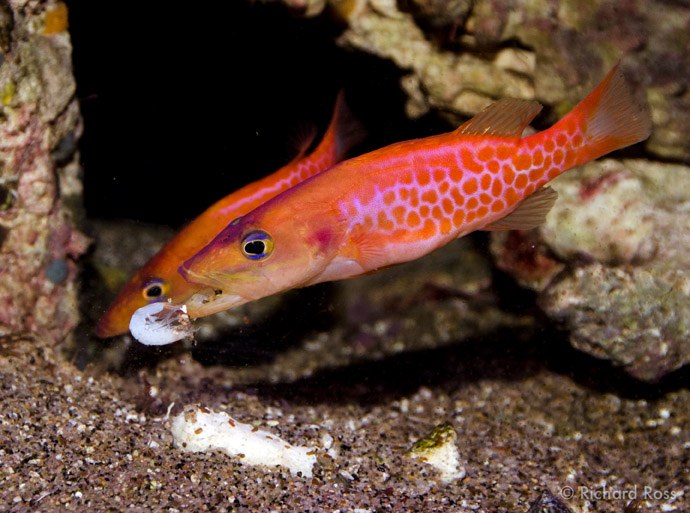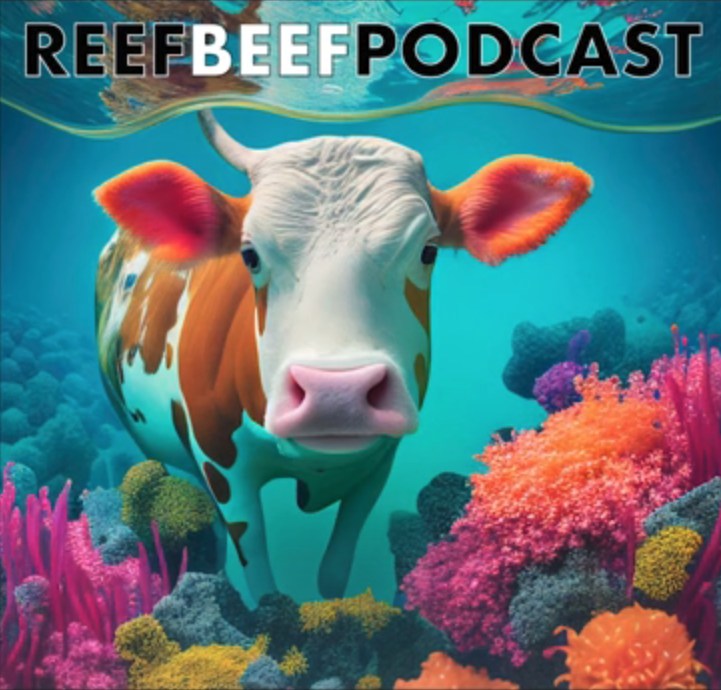From Advanced Aquarist
Back in March, I wrote about Chad Vossen feeding a platinum clownfish that was to be culled to juvenile Dwarf Cuttlefish, Sepia bandnesis, and talked about how clownfish destined to be culled might be a great source of marine feeders for predatory marine animals. As a follow up I present to you the below video: Dr. Seuss eats Nemo. In the video I feed my pair of Dr. Seuss Fish, Belonoperca pylei, some captive bred designer clownfish that were raised in quarantine conditions, and were destined for the culling block. These clownfish were provided to me by Bay Area Reefers President, Steinhart Aquarium Volunteer (Thanks David!) and clownfish breeder extraordinaire, David Sheh.
Feeding marine predatory animals can be difficult because finding appropriate live foods can come with all kinds of problems. Availability can be challenging, as finding the right size prey items, in the quantity you need them, when you need them can be problematic. Disease and parasites from wild caught prey items can infect your predatory fish, and quarantine of such animals is and added expense, as well as taking up time and resources. Worse, the ethical issues surrounding wild caught feeder animals are significant; using animals flown halfway around the world as feeders seems exceedingly wasteful. Furthermore, with some aquarium fish potentially to be listed as threatened or endangered in the endangered species act, the practice of feeding out wild caught animals can become even more inflammatory. Cultured freshwater prey items don’t offer a great alternative as they can have a different nutritional profile from saltwater prey items, and can present sub optimal results – for example, in my experience Dwarf Cuttles fed solely freshwater ghost shrimp tend to lay much fewer eggs, and fewer viable eggs than cuttles fed saltwater shrimp.
If only there were a whole bunch of captive bred, saltwater animals that nobody wanted, weren’t sellable, and were often culled as a matter of course. Oh wait. There are.
Designer clownfish broods often contain fish with undesirable traits, oddly shaped fins (Nemo!), congenital defects, or simply don’t have the traits the breeder is looking for. Reject fish are often culled (killed, slaughtered, destroyed, put down, put to sleep, Wandering the Elysian Fields, snuffed, terminated, paid the ferryman sent to the great ocean in the sky – euphemisms are great) because of these undesirable traits. Why not use them to feed marine predators?
Ignoring the inconsistent and emotionally knee jerk, save-the-pretty-animals-don’t-kill-Nemo reactions, there are practical issues about getting these feeder fish to market and cost. However, the major objection I hear from breeders is that they are worried about this inferior stock being re-sold as cheap pets rather than as the intended feeder fish, which could effectively ruin the market for quality captive bred Clownfish. I don’t know what to do about this problem, as there well always be unscrupulous people around doing nefarious things, but I leave it to clownfish breeders to come up with solutions…after all, trying to list fish that are so plentiful as to be used to feed other fish on the Endangered Species Act has a delicious type of irony that will be hard to miss.
Of course, there are a couple potential problems with feeding clownfish to predators, but these potential problems are small and mostly easily overcome. First, clownfish seem not to be the terrible swimmers that many think they are, and if given a chance they can be difficult for predators to catch. And if they get way and then hide for enough time, the predator animal can stop seeing them as prey. Case in point, my Nega Dr Seuss Fish, Belonoperca chabanaudi, currently shares its tank with 5 clownfish that got away during previous feedings – though new clownfish are readily consumed. Second, no matter how careful the sourcing, introducing disease can always be a problem…unless of course the clownfish spawns have been raised in quarantine conditions, and they often are. As you can see in the video, clownfish feeders can be kept in large groups in small tanks where they can be quarantined and treated as necessary – as well as gut loaded with great food that will be passed along to the predator.
As I have written previously, clownfish culls seem like the perfect live feeders for marine predators – there are lots of them, they are nutritionally appropriate, and they are going to be killed anyway. We just need a way to make it happen. So, hivemind of the reef keeping world, figure it out and the appreciation of the rest of your community will be yours forever.

